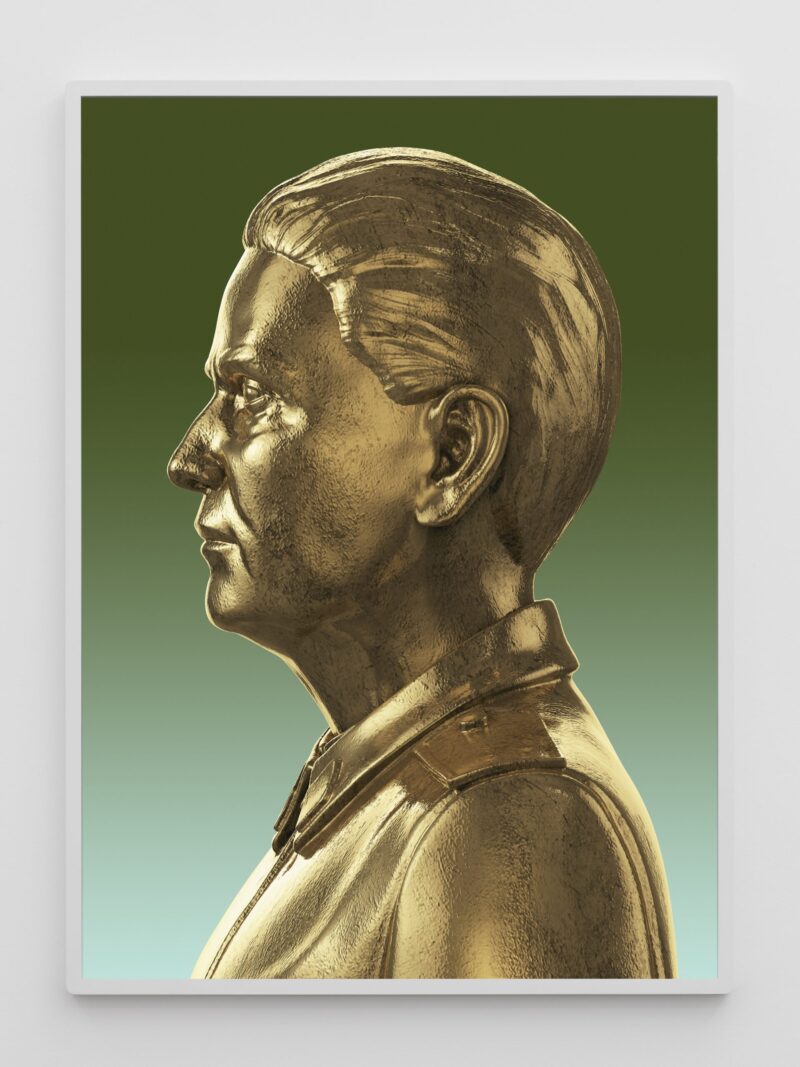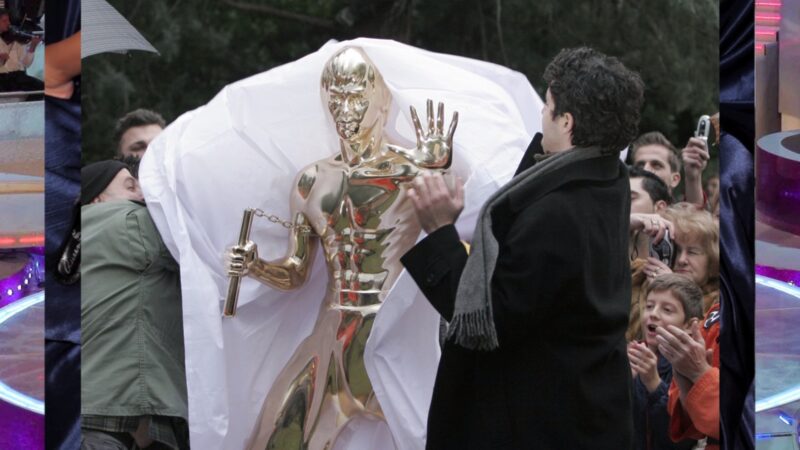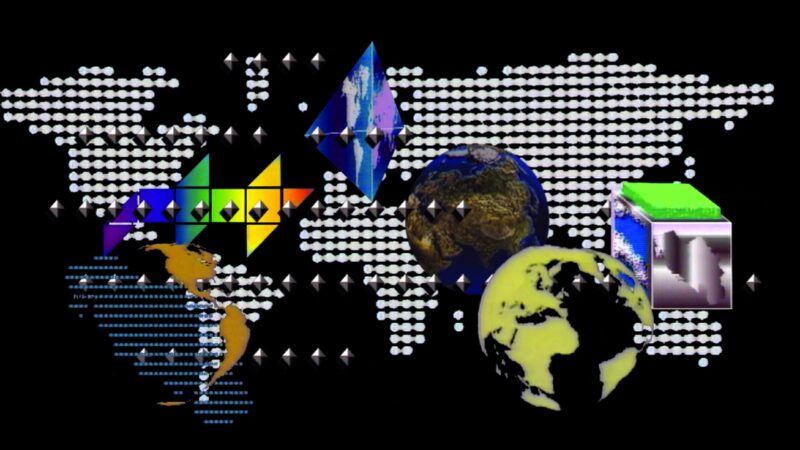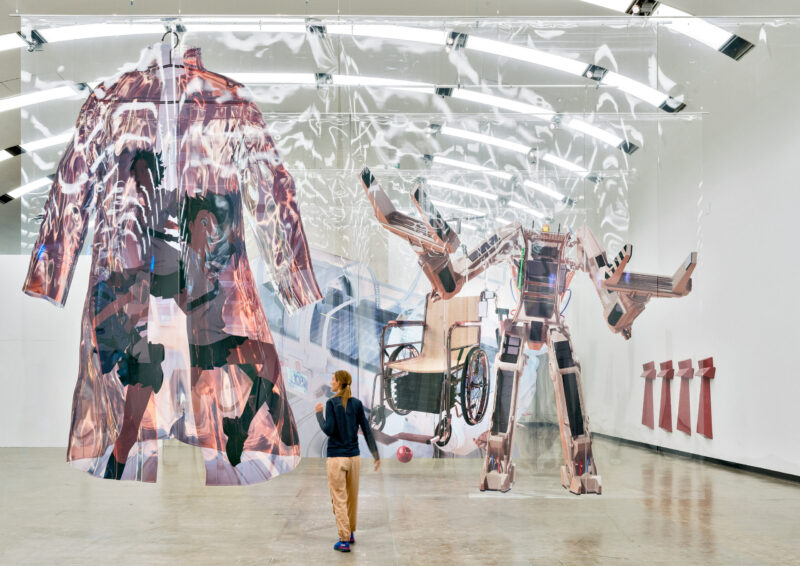by Adela Lovric // Oct. 7, 2024
Aleksandra Domanović was born in Novi Sad in 1981, when the Serbian city was still part of Yugoslavia. A few years later, I entered the world about a hundred kilometers away, in Croatia; meanwhile, she and her family moved to Slovenia. In time, her journey took her to Vienna for her studies, and eventually to Berlin, where she still resides. As I reflect on the parallels between her trajectory and mine (including my brief stint as a student in Austria and a decade of life in Berlin), I’m struck by a profound difference, one that resonates in her art. Experiences of the 1990s referenced in her works feel more distant, mediated, less shadowed by the brutalities of war and the collective trauma that marked the time. Her focus rests on the shifting tides of identity and culture as the former SFRJ disintegrated, changes that were influenced by the coinciding rapid growth of internet use and the proliferation of global commerce. While rooted in the complexities of former Yugoslav territories, Domanović’s gaze is distinctly filtered, nonsentimental, offering a contemplative, roundabout reflection rather than a direct confrontation with the politics of the time. This point of view, somewhere between an insider’s and outsider’s, resists being defined by war and instead centers technological and socio-cultural curiosities that present a more intricate portrait of the Western Balkans.

Aleksandra Domanović: ‘Portrait (mesing),’ 2012 // Courtesy Valeria and Gregorio Napoleone Collection
Domanović’s first survey exhibition, which inaugurated a new season at Kunsthalle Wien under the artistic direction of recently appointed Michelle Cotton, presents artworks created over the past 18 years. Spanning from early net art pieces produced during her studies at the University of Applied Arts in Vienna to newly commissioned and updated works, it showcases her multifaceted practice in sculpture, video, print, photography and digital media. Among over 40 artworks, I delight mostly in the playful nods to our shared collective memories. The iconic figure of Yugoslav president Tito is both monumentalized and subverted in Domanović’s 2012 silk-screen piece ‘Portrait (Mesing).’ Echoing a Balkan twist on Andy Warhol’s ‘Mao,’ it undermines his enduring cult of personality while also, perhaps inadvertently, celebrating it. The true subversion lies in the artist’s “queering” of Tito’s image: she initially commissioned a 3D model of his bust with feminized facial features. The subtle alteration quietly challenges the propagandistic omnipresence of Tito’s image that once dominated Yugoslav society. Domanović belongs to a generation that grew up with the image of “comrade Tito” prominently displayed above classroom chalkboards. The idea to feminize it emerged from this memory—she observed a striking resemblance between his features and those of her female teacher.

Aleksandra Domanović: ‘Turbo Sculpture,’ film still, 2010–2024 // Courtesy the artist and Tanya Leighton, Berlin and Los Angeles
In a somewhat similar vein, Domanović’s film ‘Turbo Sculpture’ (2009/2024) tackles post-Yugoslav nationalist and antinationalist sentiments amid the trouble of dealing with the region’s contested past. By collaging texts and images from news websites, the work examines the phenomenon of celebrity monuments erected across the Western Balkans in the early 2000s. Statues of real and fictional pop culture figures like Madonna, Bruce Lee and Rocky, alongside politicians such as Bill Clinton and Tony Blair, were symbols of distancing from the past and aspirations toward a pro-Western future. The epilogue, added for this exhibition, highlights a more recent resurgence of nationalist tendencies. These new, towering monuments of figures from antiquity and the Middle Ages glorify, in an indirect way, current populist leaders such as the controversial Serbian president Aleksandar Vučić.
‘19:30’ (2010–2011), a film in which Domanović compiles graphics and music from Yugoslav television news broadcasts spanning 1958 to 2010, stirs a deeply felt memory. In my family, like most others during the 1980s and 1990s, watching the evening news was a ritualistic event. Through this viewing, we collectively witnessed Yugoslavia disintegrating, the war unfolding and national identities scrambling anew. The importance of media amid these events cannot be overstated, and Domanović captures its emotional resonance with remarkable precision. She juxtaposes the news intro collage with footage of 1990s techno parties. For Domanović and many young people during that time, raves provided a ritualistic countercultural space, offering freedom, tolerance and the possibility of an identity untethered from nationalistic constraints and traumas of war.

Aleksandra Domanović: ‘19:30,’ film still, 2010/11 // Courtesy the artist and Tanya Leighton, Berlin and Los Angeles
Domanović’s practice is characterized by a playfully inquisitive approach to information culture, mass media and the evolving relationship between humans and machines, while also foregrounding the often-overlooked contributions of women to technology and science. Her video piece ‘From yu to me’ (2013) revolves around Yugoslavia’s former web domain, ‘.yu,’ while charting the arrival of the internet and the concurrent collapse of socialism in Eastern Europe. It honors Borka Jerman Blažič and Mirjana Tasić, two female computer scientists who registered and administered the domain. Another standout among her works that probe the intersections of gender, identity and the history of technology and science (or science fiction) is the visually arresting ‘Things to Come’ (2014). This installation of large, celluloid-like transparent sheets suspended from the ceiling invites viewers to walk through and between them. Each features an image that references famous sci-fi films, evoking objects that Domanović associates with their female characters, creating a layered dialogue between on-screen and behind-the-scenes representation. To that end, it also features a reproduction of a 1938 rejection letter from Walt Disney Productions to a female job applicant, which states that “[w]omen do not do any of the creative work in connection with preparing the cartoons for the screen, as that work is performed entirely by young men.”

Aleksandra Domanović: ‘Things to Come,’ 2014, Courtesy the artist and Tanya Leighton, Berlin and Los Angeles; ‘Bubanj Fist Relief,’ 2012, Courtesy Corporate Collection Switzerland; installation view, Kunsthalle Wien, 2024 // Photo by Iris Ranzinger
As this survey indicates, Domanović resists settling into any one medium or theme, yet her works form together a highly cohesive narrative. It’s a unique pleasure to encounter so many of her works in one place—the power of each piece is amplified in dialogue with the others, strengthening the impact of the whole. Straddling the line between the serious and the facetious, her artworks layer autobiographical and collective memories, question national, cultural and gender identities, and trace historical connections in a singular manner. For the Viennese audience, this refreshingly current exhibition—in tandem with Croatian artist Nora Turato’s mural that wraps around Kunsthalle Wien’s façade—serves as a timely reminder of their Balkan neighbors and Austria’s ties to the former Yugoslavian countries. The choice to show these two artists as the season openers is particularly pertinent in light of the recent legislative election, which saw the far-right Freedom Party of Austria score nearly 30 percent of the vote. It may also offer a respectful nod to Michelle Cotton’s predecessors, the Croatian curatorial collective WHW, whose departure from their leadership role remains shrouded in ambiguity.
Exhibition Info
Kunsthalle Wien
Aleksandra Domanović
Exhibition: Sept. 9, 2024-Jan. 26, 2025
kunsthallewien.at
Museumsplatz 1, 1070 Vienna, click here for map


























